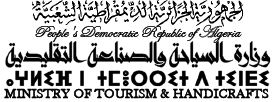traditional fabric
Traditional weaving is one of the most important branches of traditional activity in the state, where many craftsmen go to it despite the problems faced by this field, the most important of which is the problem of marketing and lack of production.
This craft is characterized by originality, creativity and tradition, and the region of Ouargla has known an artistic touch in the field of traditional weaving, where the family relied primarily on textiles in furnishing and home decorationy She was made of wool and lint, tents, mattresses, and covers, and she had a role to decorateaand living at the same time; This strong connection between living and use was imprinted in it with some signs and symbols that characterize the fabric of each region separately, and this is clear in those drawings and inscriptions that characterize the paper tapestry and we find that: in the Azraq carpet, Sedrata, the Great Mosque…etc.
This distinction leads to the emergence of several important types of carpets in the history of the region.
The most important types of traditional carpets in Ouargla:
The carpet in the Wilayat of Ouargla is one of the most important types of carpets that characterize the southern states, where some of them have gained international fame and have won several international awards, such as the Hunting Theater carpet, which won the International Prize in Milan in 1974.
The most important of these carpets are: Sedrata carpet, Farfara carpet, Kinkila carpet, Great Mosque carpet, Fishing theater carpet, Agrida carpet, Azraq carpet, Tizmat carpet.
Problems with this craft:
- Strong competition from industrial fabric.
- Lack of raw material with high prices, if any.
- Low demand for it due to its high cost.
- Support directed to this craft is not enough to regain its position.
- Closure of the carpet production unit in the Chamber of Traditional Industry
- Closure of the apprenticeship operations that were carried out by the room and the absence of professionals in textiles.
- The absence of the marketing component in the production process.
- The program to support the traditional industry in the rural area has stopped.
- Lack of support aids.
Some solutions and suggestions:
The situation of the traditional textile sector in the state of Ouargla is not much different from its situation in most states of the country, where it suffers from the same problems: marketing, raw material, labor, competition. Also, most of the proposed solutions put forward in the field revolve around:
- Finding new formulas to open and restore markets in the field of traditional weaving, where the craftsman can continue the production cycle and secure a permanent job position.
- Finding solutions to the problems of raw materials by providing them through the structures of the traditional industry sector related to the promotion and development of traditional industry.
- Providing auxiliary equipment to ease the muscular effort of the craftsman and the speed of production.
- A cost scheduling study in order to reduce the difference between the price of traditional and industrial production.
- ‘Dark’Dr Promotional Marketing Policiese During international and national demonstrations and the development of means of promotion.
These suggestions would revive the traditional textile sector in the state and balance the textile market parameters somewhat, while raising the level of professional qualification and professionalism in production.
Conclusion
The traditional textile sector is among the most important branches of traditional craft activity in the Wilayat of Ouargla, as it is characterized by daily use: the manufacture of traditional clothes (Al-Brunos, Al-Qashabiya, traditional patterns), the manufacture of mattresses and covers, the manufacture of traditional carpets.
The focus was on the traditional carpets available at the level of the Wilayat of Ouargla, which gained international fame, including: a hunting theater carpet, attached to the study with an information card on each carpet and an illustration.
In addition to the problems and the reality of humiliation in it, as well as the supporting projects and the obstacles it faced. Finally, we came up with a number of suggestions in the field of promotion in order to improve the situation.


